
MARS SOUTH POLAR CAP BIO-LIFE
Report #122
July 2, 2007
Large continuous report with 9 images & slow loading
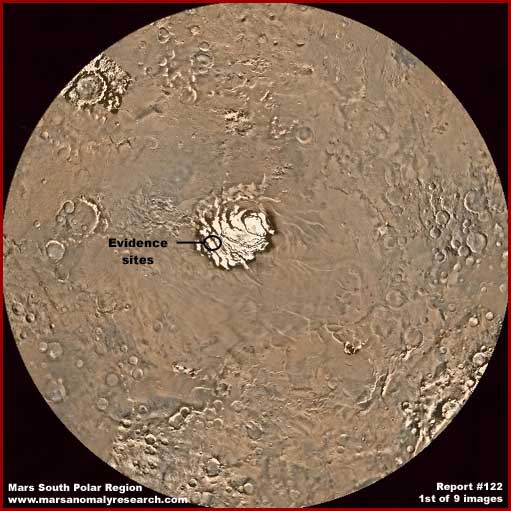
The above first image is a view of the South Polar Region with the Cap as the white mass at the center. The labeling points out the location of the multiple evidence sites on the left side of the Cap. As you can see, the evidence is well up on the top of the Cap's surface.
The Mars South Polar Cap ice mass according to official science is suppose to consist primarily of carbon dioxide (CO2) ice concentrations. Now water ice and CO2 ice look the same appearance wise, so how do they arrive at the CO2 identification? Well it's pretty simple really. Previous instrument science data says that the Mars atmosphere is made up primarily of 95.32% CO2 with only faint trace amounts of nitrogen at 2.7%, oxygen at 1.6%, and water vapor at .03%. Compare that with the Earth atmosphere of nitrogen at 78.084%, oxygen at 20.946%, water vapor averaging around 1.00%, and CO2 at .038%. As you can see, according to the official statistics, there is a very big difference between the two worlds.
So, if the Mars atmosphere is almost all CO2, how does it collect on the Mars surface in great concentrations forming the Polar Caps? The answer is cold, super hard freezing cold and the Mars temperatures would of course be expected to be the coldest at the Poles. Sure enough official science data tells us that the average temperature on Mars is around –63º C. or –81º F. but in the South Polar Region it can get as cold as –140º C. or –220º F. That's serious super hard freezing cold to put it mildly. Here on Earth CO2 freezes under normal conditions at about –56.6º C. or –69.8º F., so you see that with the official Mars temperatures as stated CO2 can freeze readily out of the air and drop to the ground as CO2 snow and accumulate over time into the ice masses seen at the Poles.
Also, you should know that CO2 is one of the most powerful cerebral vasodilators known. For Earth humans sustained exposure to CO2 concentrations of as little as 3–5% (molar) start being deadly to life and compare that with a Mars 95.32% CO2 atmosphere. So, for the the Earth human who takes a stroll on the surface of Mars without a serious containment suit, while you're instantly choking to death and dying of nitrogen and oxygen insufficiency, you're also being intensely poisoned by many times over with mega proportions of toxic CO2. In other words, it could mess up your day! Still feel like a trip to Mars?
Obviously, it is hard to consider that biological life of any kind that we might be aware of trying to survive in such a hostile South Polar environment must less on the Cap itself at the center of the freezing conditions and thriving. Yet that is the nature of the evidence I am presenting here. The logical implication will of course be that the the Mars atmosphere is not 95.32% CO2 as promoted nor is the temperature as super hard freezing cold as stated. You be the judge.
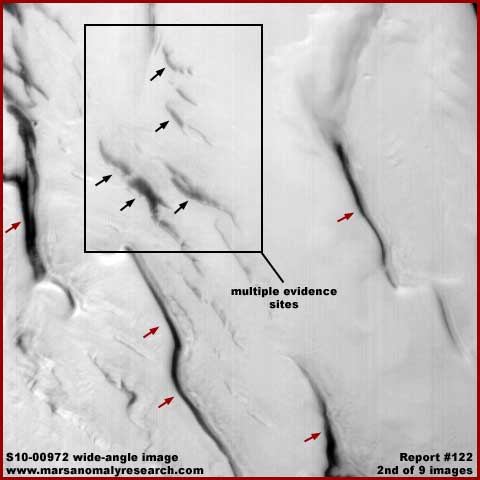
The above second image provides a bit closer context view of the general site on the South Polar Cap surface. The black arrows inside the black box outline point out the reporting sites of interest here and what they look like in this very distant wide-angle view. The red arrows point what is no doubt similar but much larger much more mature evidence sites likely of the same kind but which no science data images are released to us on. This latter factor is important because of its implications.
I suspect that this is because these more mature sites are much more massive with their huge scale making them impossible to obfuscate without blanking out the whole image. In other words, the evidence that you will be able to see here no doubt represents only much smaller less mature versions of this type of evidence that can reach really massive proportions. Note in the above second image how the larger evidence pointed out by the red arrows tends to rise up in height on the right along a long leading edge casting a deeper more pronounced shadow and then taper back to the left down into the terrain very much like a cresting wave coming in from the sea. This is a signature characteristic of this evidence as found in this open terrain adding to its strangeness.

The above third image is a composite of three images showing a distant view of several of the lesser evidence sites reported on here. Now you can begin to appreciate my description of these looking something like waves coming in from the sea to shore. In this still distant view, the bio-life evidence is the smoother uniform appearing surface with the raised leading edge darker because in part it is a raised elevated edge with a different sunlight angle striking the depth of it forming some shadow. The more rougher textured terrain is the typical South Polar Cap surface as viewed in this satellite imaging. Note how the bio-life evidence forms this elevated leading edge on our right but then tapers back down and blends in with the typical Cap terrain.
A point that you need to understand here is that the smoother appearing biological life evidence has this smoother appearance not because it is really smooth but because it is mass made up of many hundred of thousands of individual bio-life objects all of a uniform size and height as a super density packed together. The next images will demonstrate this increasingly better.
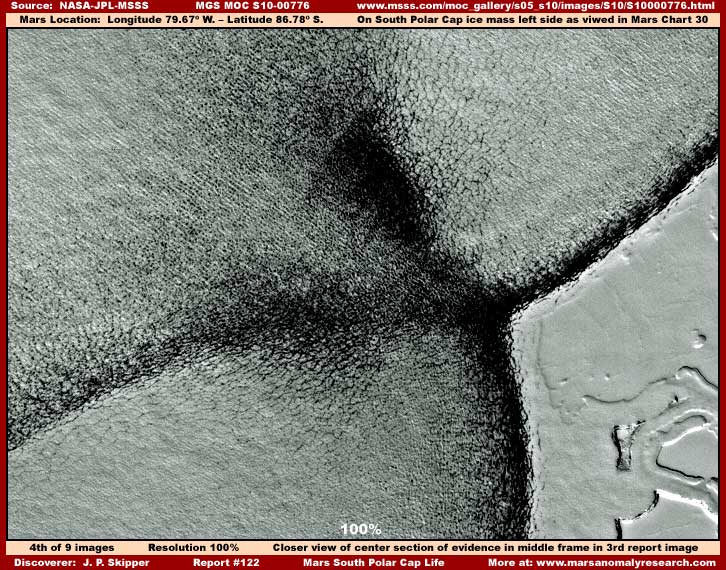
The above fourth image from the S10-00776 strip is simply a closer view of the folded area within the bio-life evidence as seen in the middle frame of the previous third report image. The resolution in this closer image isn't very good and this has impacted the evidence. Even so the faintly seen but very densely packed directionally oriented row pattern to the evidence in the upper field of this fourth image can be determined and I want you to pay attention to this pattern in this image as well as the next image below.

The above fifth image is from the same S10-00776 strip but from a location in the very top left corner. It is a 150% closer view showing just a bit more detail. Note the rounded knobby texture patterns to the left in the bio-life evidence back field but the very densely packed row pattern at the leading edge of the mass and where it rolls over and downward to the Cap terrain.
Now I want you to go to my 2005 Report #082 titled "Mars Shoreline & Life Evidence." First note that report's evidence is located not up on the top interior areas of the Cap but at its lower left edge where there appear to be sea shore water influences. In that report pay particular attention to the visual evidence in the third and especially the fourth images. Note that the bio-life evidence there is very similar to the fourth and fifth image evidence here in this report except that the Report #082 evidence may be under some kind of artificial clear protective cover with its edges clearly identified terminating on the shore.
So that Report #082 evidence may be influenced by cultivation and managed water intrusion whereas the evidence here in this report appears to be wild on the open South Polar Cap ice mass. I mention this because these factors can influence the bio-life evidence and probably its general appearance as it adapts to differing environmental conditions.

The above sixth image from a different S10-01534 strip offers a closer view of the rolled leading edge of this type of evidence. Not only is it a closer view, it also is focused obliquely on the leading elevated rolled edge of the bio-life mass with most of the sunlight coming ideally from behind illuminating the bio-mass edge. There was more of this closer view evidence above this point in the original strip but conveniently imaging artifacts destroyed most of that evidence leaving only this small edge amount alone.
Note that all of the multitude of individual objects back behind the leading edge are basically the same size and height and super densely packed in this super dense mass. Now you can perhaps understand why any one of these masses looks so uniformly smooth when the view of the mass is more distant as in the much of the previous images here as all these individual objects blur and visually merge together. Even in this closer view, note how the mass is still very dense right up to the edge sharply defining this mass of bio-life from the rest of the Cap terrain.
The bio-life evidence in the 2nd through 6th images here in this report appear to be surviving and doing well wild not only out in open conditions but on what is essentially just ice. Do you really believe that this bio-mass can do this on lethal CO2 ice or could it actually be water ice? Further, do you really believe it can do this on the Cap itself where temperatures can fall to as freezing cold as –140º C. or –220º F. that would almost certainly disrupt living cellular structure or might one consider that temperatures are less extreme?
It may be that the densely packed "wave" mass formations are an adaptation to this kind of open colder Polar Cap environment. Perhaps each object generates a limited measure of warmth that is accumulative and sufficient when the objects are densely packed and that's why advancing over ice mass terrain must be accomplished as a tight knit collective mass. Could it be that this is an adaptation to more tolerable but still Polar Cap cold conditions as the mass spreads and advances via its protective density along these leading edges over a water infused ice base?
Meanwhile, does anyone really believe that this bio-life, even though clearly unfamiliar to us, is not just surviving but flourishing here on top of lethal C02 ice at temperatures of –56.6º C. to 140º C. or –69.8º F. to –220º F.? The obvious implication is that the Cap is water ice and the temperature, while cold enough to maintain water ice mass in a frozen state, isn't the super freezing cold as officially promoted. The next images and their similar but different evidence will continue to push this concept home.
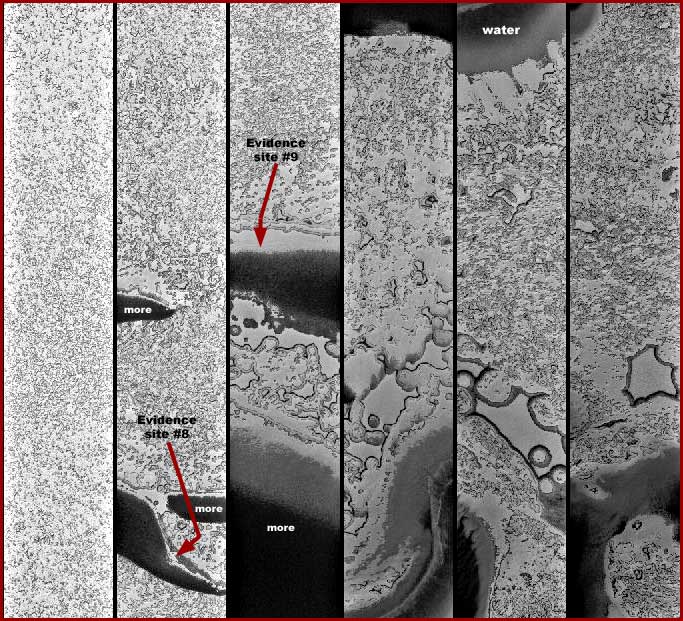
The above locator image from the very long R14-00405 narrow-angle strip examines some very similar bio-life evidence but this evidence appears to specialize in accumulating in and around water sites compared to the 2–6 images evidence. The red arrows point out the two primary bio-life evidence sites that I have used for sample reporting purposes here in the following images #8 and #9. The word "more" appears at other sites demonstrating the same kind of bio-life evidence. You'll also note a site label "water" and that's just what it is but this reporting is about bio-life and so I'm not going into that here.
I would now like to draw your attention to the above site #9 pointed out with the red arrow in the mid area of the third from the left frame. On the underside of the upper larger dark area (not imaged here), there is a smaller slightly lighter but still relatively dark area. This is the same bio-life evidence but it is of a finer texture and smoother appearance bordering on a body of what appears to be frozen water. Now move your eye to the next to last and last frame on the right. Note the two frozen bodies of water sites there with dark band around the outer boundaries as well as ringing islands in the water bodies.
I don't have time or room to go into this here in this report but this evidence is important too. It is the same bio-life as in the dark blocks I have imaged here but it is of a smoother appearance because it is no doubt of a less mature development. Many of what appear to be frozen bodies of water around on the Cap have these dark but detail indistinct bands around them. This similar growth that I am reporting on here in the latter stages of this report appears to be attracted to these bodies of water and their shorelines whether liquid or ice.
Apparently, when water conditions are right among no doubt other unknown factors at work, the growth ringing these sites transforms into the physically larger knobby rough texture pattern growth form you see here in the next images #8 and #9. The transforming growth then engulfs the water site completely but still never leaving its boundaries suggesting that water is the trigger. Because this growth is larger and easier to recognize as living growth, that is what I've reported on here as follows.

The above eighth image is a 200% closer view of one of the bio-life sites in the R14-00405 strip. The huge size scale of the biolgoical-life evidence here over powers the poor resolution bringing the evidence into better view. It is hard to imaging bio-life evidence getting more obvious than this in this compromised satellite imaging. It speaks for itself.
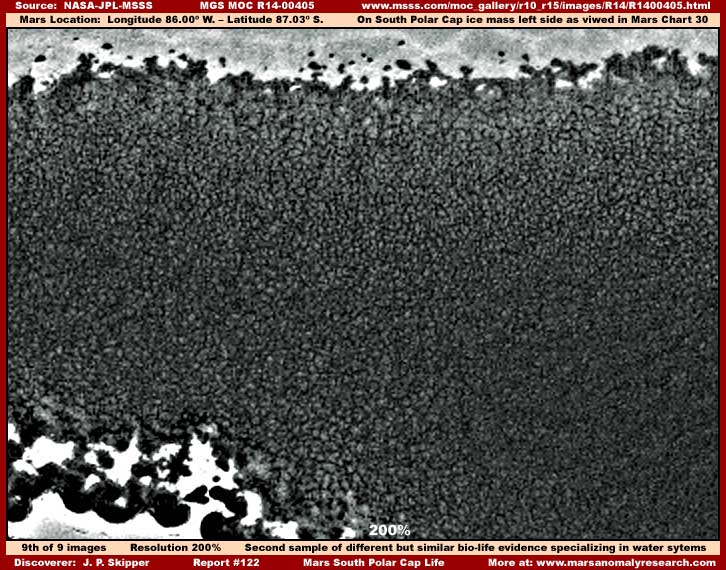
It is the same with the above ninth image of another sample evidence site a little further down in the same strip. Again it is difficult to imagine biological-life evidence getting any more obvious than this. Again it speaks for itself.
Remember, all of the evidence you've seen here in this report is located up on the South Polar Cap ice mass right where the temperature can be expected to be the coldest it will ever get in the southern hemisphere. Yet here is all this biological-life evidence in huge successful thriving masses and in a large size mature form that without a doubt took many seasons of growth to achieve. What is it you are going to believe, hard visual bio-life evidence that is verifiable by your own efforts brought to you by an independent researcher drawn from your leadership's own satellite exploration evidence record that they never want to mention or bring to your attention or will you accept their mantra of trust us we know what is best for you?
What to believe? Where is the truth? You don't have to believe what others tell you, including me. Find out for yourself. Go to the links below at the end of this report (not my images) and download the straight .GIF browser compatible official science data image files on each image strip because the .GIF files are browser compatible and have the best detail. If you don't have the software graphics skills yourself, put the files on a CD or DVD and take them to the graphics department of your local school or university and get someone there to examine them for you in your presence. In other words, verify and satisfy yourself of this evidence and its reality.
When you have done so, then ask yourself why such evidence can be and is being officially so thoroughly and clearly intentionally ignored as though it doesn't exist at all. If it isn't already apparent, the answer will become logically and painfully obvious and even a little scary. Someone here on Earth doesn't want us to be able to recognize this evidence for what it really is and they're actively leading us psychologically away from such recognition via misdirection in the opposite direction. With this awareness instantly comes the question of why? Yes, that is the 64-million dollar question isn't it?
What is so needful of such avoidance? Do you believe it is a bunch of simple biological life like you see here or a life supporting water evidence on Mars? Can't find anything sufficiently scary about that? How about other intelligent life civilizations? What's so scary about that? So what if they are technologically advanced beyond us? If they are so advanced, how do they represent a threat to us? If they are there, then they've been there the whole time all during the last 6 to 7 thousands years of our own Earth civilization and we're still here and unharmed going about our everyday business. Where's the external threat and what's to fear?
Could it be that the biggest thing that we have to fear is ourselves? Is our psychological health so paper thin that we can't adjust to anything new and real and possibly life changing without flipping out and flying to pieces? Is that what the secrecy is all about, to protect us from our own fragile psychologies? We each need to examine ourselves. Are you going to flip out if you discover that we're someone else's experiment or that your personal religion is a suspect of external manipulation? Are you going to come apart and drift aimlessly over that? Are you so intolerant of the new and different? Is that what you fear most, difference? Are we all that screwed up and fragile?
On the other hand, could it be that secret knowledge is power and wealth? Could it be that a few here on Earth are trying to hold on to that secret knowledge extracting technological advantage for their personal benefit along the way justifying that what is good for the few is good for the many and the price is worth it for all? The powerful get rich and the rich get richer and at who's expense? Sound familiar?
I can't answer these questions conclusively enough for you as that would be conjecture and a long way from evidence. What I can say with confidence is that the ignorance and uncertainty that secrecy generates is never good. We must all decide what we want as individuals. I can tell you what I want. I want not a version of the truth but THE TRUTH and I'm prepared to adapt my life to what ever that truth/reality is and in the process try to see that Earth human kind all benefit from what ever that truth is for those who will allow the truth into their lives. It is a matter of personal choice. So where do you stand? Getting fed up yet?
DOCUMENTATION
http://www.msss.com/moc_gallery/s05_s10/images/S10/S1000971.html: This link takes you to the official MGS MOC S10-00971 and S10-00972 science data strips from which the evidence in my second image here as well as the first frame on the left in my third image here were sourced from.
http://www.msss.com/moc_gallery/s05_s10/images/S10/S1000776.html: This link takes you to the official MGS MOC S10-00776 science data strip from which the evidence in my third image middle and right frames as well as the fourth and fifth images were sourced from.
http://www.msss.com/moc_gallery/s05_s10/images/S10/S1001534.html: This link takes you to the official MGS MOC S10-01534 science data strip from which the evidence in my sixth image was sourced from.
http://www.msss.com/moc_gallery/r10_r15/images/R14/R1400405.html: This link takes you to the official MGS MOC R14-00405 science data strip from which the evidence in my seventh, eighth, and ninth images were sourced from.
, Investigator
![]()